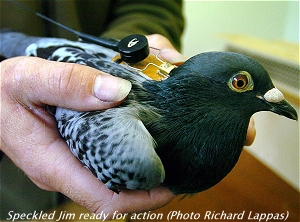Revenge of Speckled Jim
The Times and other nationals (3rd September, 2005) (Nick Constable)

A homing pigeon smeared with lethal pesticide by its owner and left as live bait for nesting falcons has taken revenge by leading police back to the poisoner.
In an audacious hi-tech operation wildlife protection officers rescued the sick bird, nursed it back to health and fitted it with a special back-pack containing a radio transmitter.
They then followed its flight home with help from five falconers using mobile tracking devices.
The pigeon - named Speckled Jim - yesterday led police and Defra investigators to a house near Ashburton, South Devon, believed to be owned by a fancier.
Police say any child which had touched the bird, and consumed traces of the poison, could have been killed within hours. The pigeon was found in the garden of an Ashburton child-minder.
Inspector Nevin Hunter, senior wildlife officer with Devon and Cornwall Police, said:'This substance is extremely dangerous to people.
'If we'd ended up with a dead child we'd now be looking at a manslaughter charge.
'We suspect pigeon fanciers are poisoning peregrines in the misguided view that they have a right to protect their birds. Until we catch the people responsible this a tragedy waiting to happen.'
Tests by scientists at the Pesticide Safety Directorate show the poison used was concentrated aldicarb - one of the most toxic pesticides ever manufactured.
It is already banned in most European countries and supermarkets led by Tesco and Waitrose no longer sell potatoes sprayed with it. Britain is due to comply with an EC-wide ban in 2007.
The poisoner is thought to have mixed the poison undiluted with grease before spreading it onto the pigeon's skin.
He also clipped its wings to make it an easy target for peregrines.
Inspector Hunter said Speckled Jim would normally have died from absorbing the aldicarb. However he survived because ferocious rainstorms across Devon earlier this month washed much of the poison away before it could take effect.
Local falconers then nursed the pigeon back to health and stuck on replacement feathers, a process known as 'imping' They also provided police with a miniature radio transmitter and trackers - standard equipment for locating lost birds of prey and accurate to within 1.5 metres.
Officers suspect other homing pigeons have been deliberately contaminated in what is a concerted attack on peregrine falcon breeding sites.
A dead falcon was last week found in a quarry near Buckfastleigh, Devon, and two orphaned peregrine chicks were recovered from a quarry near Ashburton.
It is thought their parents both succumbed to poison.
Defra investigator Ivan Lakin said the dead peregrine was found slumped over the corpse of a baited pigeon.
'It died so quickly it didn't move,' he said. 'Aldicarb appears to be the poison of choice for persecuting peregrines.'
Inspector Hunter admitted that the Speckled Jim operation had been a long shot
'Not all homing pigeons want to fly home,' he said. 'But given the risks to people and protected wildlife we decided this was worth a try.'
There are around 4,000 peregrines in the UK, mostly found in the far west and south-west. Of these, around 1,400 are breeding pairs. All are listed under schedule 1 of the Wildlife and Countryside Act 1981 - the highest protection offered by law.
According to the Royal Racing Pigeon Association, each falcon takes up to ten pigeons a day during the nesting season. Falconers dispute this, claiming the maximum is three or four.
The RRPA has always condemned illegal poisoning of birds of prey and is currently campaigning for a change in the law to allow selective culling.
Aldicarb is used on British farms to kill bugs on potato, carrot, onion and parsnip crops.
It is so powerful that in 1998, just 270 parts per million in a cabbage salad served at a Louisiana works canteen was enough to put all 12 diners in hospital.
Research by the Lille Poison Centre shows 39 people were poisoned by aldicarb in northern France between 1998 and 2001. Two of the victims died.

 WANTED - War Stories
WANTED - War Stories